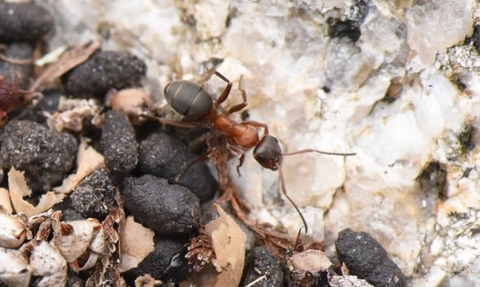
Red-barbed Ant
Red rarities
Burrowing in bare patches of earth, the red-barbed ant is an endangered species that is currently only found in Surrey (on Chobham Common) and on Scilly. It is is Red Listed Category 1 and has its own Species Action Plan.
Red-barbed ants are the rarest ant - and indeed the rarest creature - in Britain, only existing in a handful of colonies, most of which are on the Isles of Scilly. The red-barbed ant requires successional heathland and dry, sun exposed habitat for nesting and foraging. Suitable habitat involves bare ground, short grass and heather mosaics over loose or sandy soils within maritime heath and grassland. Nests are either excavated in the ground or under stones.
The red-barbed ant is also known as the St Martin’s ant. One of the most common places to see them is on the heathland around the Daymark on warm, sunny days. They are also found on Teän, Great Ganilly and Nornour.
They are surprisingly large and easily recognisable by its colour, as their common name suggests. Workers measure 4-8mm whilst queens can measure up to 12mm. Workers may live between one to three years, whilst queens can live for up to 14 years (but 10 years may be more usual)
Their thoraxes are a dark, distinctive red, which contrast with their dark heads and abdomens, giving them a striking appearance. Tiny hairs cover their thorax which separates them from formica cunicularia, a similar species of ant.
Whilst the red-barbed ant in Scilly seems to be doing well, on the mainland it has been found to be struggling and close to extinction, and red-barbed ants on Scilly have been directly involved in the national conservation of the species. In 2006, a conservation programme was set up to help stabilise and increase the red-barbed ants chances of survival. The Zoological Society for London (ZSL) kept translocated red-barbed ant colonies from the Isles of Scilly at ZSL London Zoo in a purpose-built facility, whilst Surrey Wildlife Trust prepared ideal habitat conditions for their release on Chobham Common.
Red-barbed ants display a distinctive reproductive behaviour. During courtship, young winged females climb to the top of a blade of grass or plat stem to attract the attention of males by scent. After mating, new queens will try to establish a new colony.
Find out more
Red-barbed ants are one of the invertebrate species you might see if you're very lucky, but there are a whole host of beetles, bugs, bees and more that you might spot. Find out more below...



